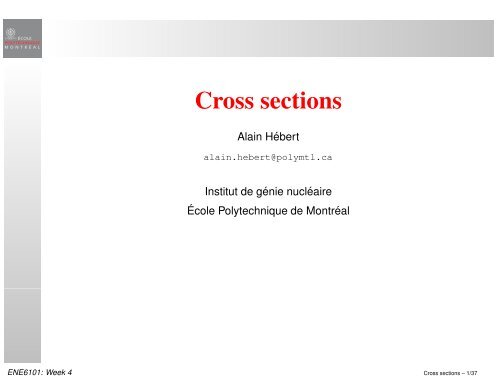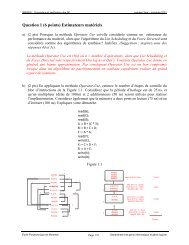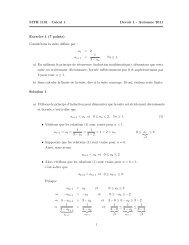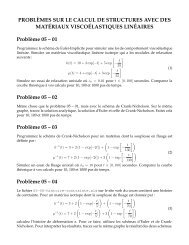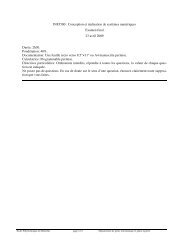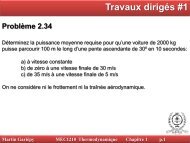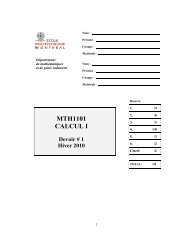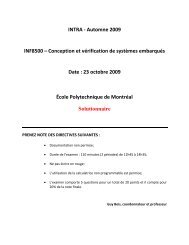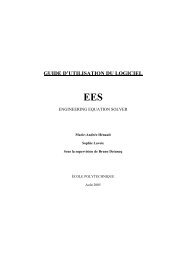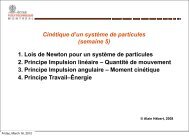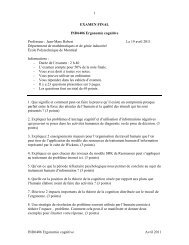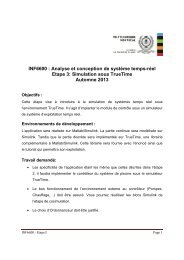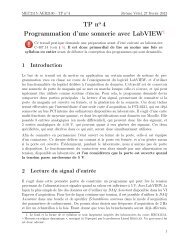Definition of cross sections 1 - Moodle
Definition of cross sections 1 - Moodle
Definition of cross sections 1 - Moodle
Create successful ePaper yourself
Turn your PDF publications into a flip-book with our unique Google optimized e-Paper software.
Cross <strong>sections</strong>Alain Hébertalain.hebert@polymtl.caInstitut de génie nucléaireÉcole Polytechnique de MontréalENE6101: Week 4 Cross <strong>sections</strong> – 1/37
Content (week 4) 1<strong>Definition</strong> <strong>of</strong> <strong>cross</strong> <strong>sections</strong>Formation <strong>of</strong> a compound nucleusselection rulesresonancesPorter and Thomas distributionWigner distributionThe single level Breit-Wigner (SLBW) formularesonance parameters <strong>of</strong> 232 Th235 U, 238 U and 239 Pu <strong>cross</strong> <strong>sections</strong>low-energy variation <strong>of</strong> <strong>cross</strong> <strong>sections</strong>ENE6101: Week 4 Cross <strong>sections</strong> – 2/37
<strong>Definition</strong> <strong>of</strong> <strong>cross</strong> <strong>sections</strong> 11. The trajectory <strong>of</strong> a neutron in a material is a straight line which can be interrupted by anuclear interaction with a nucleus <strong>of</strong> the material.2. The neutron-nucleus collision can result in a variety <strong>of</strong> nuclear reactions (such as theelastic scattering reaction).3. The concept <strong>of</strong> <strong>cross</strong> section is used to describe the probability <strong>of</strong> each type <strong>of</strong> nuclearreaction. The probability for a neutron located at r and moving in a material at velocityV n to undergo a nuclear reaction in a differential element <strong>of</strong> trajectory ds isindependent <strong>of</strong> the past history <strong>of</strong> the neutron and is proportional to ds.Let’s consider a one-speed and parallel beam <strong>of</strong> neutrons <strong>of</strong> intensity I neutrons per unitsurface and unit time. The beam hits perpendicularly a target <strong>of</strong> width ds. The targetcontains a unique type <strong>of</strong> nuclide with a number density <strong>of</strong> N nuclei per unit volume.I (cm-2 s-1)N (cm-3)ENE6101: Week 4 Cross <strong>sections</strong> – 3/37ds
<strong>Definition</strong> <strong>of</strong> <strong>cross</strong> <strong>sections</strong> 2The number density <strong>of</strong> nucleus in the target is given by(1)N = ρA 0Mwhere ρ is the density (g/cm 3 ), M is the atomic mass <strong>of</strong> one nuclide (u) and A 0 is theAvogadro number defined as 6.022094×10 23 u/g.The intensity I if the beam is obtained from(2)I = V R nwhere V R is the relative velocity <strong>of</strong> the neutrons with respect to the target and n is thenumber density <strong>of</strong> the neutrons (cm −3 ) in the beam. If the target is at 0K, V R = V n .The surfacic reaction rate dR x is defined as the number <strong>of</strong> nuclear reactions <strong>of</strong> type x perunit time and unit surface <strong>of</strong> the target. It is experimentally found that dR x is proportional tothe number density N, to the intensity <strong>of</strong> the beam I, and to the width <strong>of</strong> the target, at thelimit <strong>of</strong> zero width. The microscopic <strong>cross</strong> section σ x is defined as the proportionality factor:(3)dR x = σ x N I ds .ENE6101: Week 4 Cross <strong>sections</strong> – 4/37
<strong>Definition</strong> <strong>of</strong> <strong>cross</strong> <strong>sections</strong> 3The microscopic <strong>cross</strong> section must have the dimension <strong>of</strong> a surface to make Eq. (3)dimensionally consistent. They are generally expressed in barn (b), with 1 b = 10 −24 cm 2 . Itis also common to define the macroscopic <strong>cross</strong> section Σ x to group all the characteristics <strong>of</strong>the target in a single value. It is defined as Σ x = N σ x .If the material <strong>of</strong> the target is an homogeneous mixture <strong>of</strong> different types i <strong>of</strong> nuclides, theresulting macroscopic <strong>cross</strong> section is(4)Σ x = ∑ iN i σ x,i .Moreover, we define the total macroscopic <strong>cross</strong> section as the sum <strong>of</strong> <strong>cross</strong> <strong>sections</strong> fromall nuclear reactions. We write(5)Σ = ∑ xΣ x .ENE6101: Week 4 Cross <strong>sections</strong> – 5/37
<strong>Definition</strong> <strong>of</strong> <strong>cross</strong> <strong>sections</strong> 4I 0 (cm-2 s-1)sLet’s consider now a one-speed and parallel beam <strong>of</strong> neutrons <strong>of</strong> intensity I 0 neutrons perunit surface and unit time. The beam hits perpendicularly a slab <strong>of</strong> finite width. The collisionor total reaction rate dR is the number <strong>of</strong> collisions <strong>of</strong> neutrons in an elemental width dslocated at distance s, per unit time and unit surface <strong>of</strong> the slab. Each time a neutron collidein ds, it is removed from the uncollided beam. The reaction rate is writtends(6)dR = −dI(s) = I(s)Σdswhere I(s) is the intensity <strong>of</strong> the uncollided beam after a distance s in the slab. Integratingthis equation between 0 and s, we obtain(7)I(s) = I 0 e −Σs .ENE6101: Week 4 Cross <strong>sections</strong> – 6/37
<strong>Definition</strong> <strong>of</strong> <strong>cross</strong> <strong>sections</strong> 5The ratio I(s)/I 0 is the probability for the neutron to be uncollided after a distance s. Theprobability <strong>of</strong> an interaction for this neutron in the following elemental width ds is Σds. TheprobabilityP(s)ds for a neutron in I 0 to collide in ds is therefore(8)P(s)ds = Σe −Σs ds .This equation is useful to define the mean free path λ <strong>of</strong> neutrons in an infinite slab, animportant quantity in reactor physics. The mean free path is the average trajectory length <strong>of</strong>the neutrons in an infinite and homogeneous material. This value is obtained from equation(9)λ =∫ ∞0dssP(s) = 1 Σ .ENE6101: Week 4 Cross <strong>sections</strong> – 7/37
<strong>Definition</strong> <strong>of</strong> <strong>cross</strong> <strong>sections</strong> 61. Each type <strong>of</strong> nuclear reaction is characterized by a specific microscopic <strong>cross</strong> sectionσ x which is also function <strong>of</strong> the type <strong>of</strong> nuclide and on the velocity or kinetic energy <strong>of</strong>the neutron. However, the potential <strong>cross</strong> section is independent <strong>of</strong> neutron energy.2. An elastic neutron-nucleus collision is characterized by an elastic scattering <strong>cross</strong>section σ e . This reaction includes both potential and resonant elastic collisions.3. The symbol Q represents the energy produced by a nuclear reaction in the form <strong>of</strong>kinetic energy. In a threshold reactions, Q is negative and the nuclear reaction canoccur only if e exc ≥ −Q. If a scattering reaction has a threshold energy −Q, thecompound nucleus is left excited after the collision and decay with gamma rayemission <strong>of</strong> energy −Q (short half life). This is the inelastic scattering <strong>cross</strong> section(σ in ).The scattering <strong>cross</strong> section σ s is written σ s = σ e +σ in + ∑ x≥2 σ n,xn.σtotalσsσe σin σn,2n σ n,3n σfσγσασpscattering(n,xn)absorptiontransmutationENE6101: Week 4 Cross <strong>sections</strong> – 8/37
<strong>Definition</strong> <strong>of</strong> <strong>cross</strong> <strong>sections</strong> 7In a similar way, we may define <strong>cross</strong> <strong>sections</strong> for reactions involving the absorption <strong>of</strong> theincident neutron. A representation <strong>of</strong> this hierarchy is given in figure.Nuclear reactions in reactor physics are <strong>of</strong>ten represented with the following notation:(n,n):(n,n’):(n,γ):elastic scattering,inelastic scattering,the radiative capture <strong>cross</strong> section σ γ(n,f): the fission <strong>cross</strong> section σ f ,(n,α), (n,p):(n,2n):transmutation <strong>cross</strong> <strong>sections</strong> σ α (an α particle is emitted)or σ p (a proton is emitted)n-2n reaction, etc.All these reactions, with the exception <strong>of</strong> the potential scattering, involve the formation <strong>of</strong> acompound nucleus and are characterized by <strong>cross</strong> <strong>sections</strong> that may exhibit high variationwith neutron energy. This phenomena will be studied in the next section.The total <strong>cross</strong> section is the sum <strong>of</strong> all existing <strong>cross</strong> <strong>sections</strong>.ENE6101: Week 4 Cross <strong>sections</strong> – 9/37
Formation <strong>of</strong> a compound nucleus 1Any nuclear reaction with formation <strong>of</strong> a compound nucleus are proceeding in twosuccessive steps:1. The incident neutron is absorbed by the target nucleus A ZX to form an excited state <strong>of</strong>nucleus A+1ZX called the compound nucleus. During the formation process, theavailable kinetic energy <strong>of</strong> the incident neutron e exc and the binding energy <strong>of</strong> thisadditional neutron S n (A+1,Z) are distributed among all the nucleons <strong>of</strong> thecompound nucleus. The binding energy is computed in term <strong>of</strong> the mass default using(10)S n (A+1,Z) = [M(A,Z)+m n −M(A+1,Z)]c 2where M(A,Z) is the mass <strong>of</strong> isotope A Z X expressed in u, m n = 1.008665u is themass <strong>of</strong> the neutron and c 2 = 931.5MeV/u is the square <strong>of</strong> the light velocity in void.2. The compound nucleus decay with a half life between 10 −22 and 10 −14 second,without reminding how it was formed. The neutronic reactions are not the only onesthat can produce a compound nucleus; a photo-nuclear interaction (with an incident γray) can produce the same effect. This decay can occur following a number <strong>of</strong> decaychannels, as represented in table. Each decay channel involves the production <strong>of</strong>secondary rays and/or particles which can emerge in ground or excited state.ENE6101: Week 4 Cross <strong>sections</strong> – 10/37
Formation <strong>of</strong> a compound nucleus 2Type <strong>of</strong> reactionNumber <strong>of</strong> decay channels1○ elastic scattering 1 channel2○ inelastic scattering 1 channel if e exc ≥ −Q3○ radiative capture very high number <strong>of</strong> channels4○ fission ≃ 2 or 3 channels if e exc +S n ≥ e fThe compound nucleus model consists to write the interaction as a two-stage reaction,(11)AZ X +1 0 n → A+1Z X∗ →where the asterisk indicates that the compound nucleus is in an excited state. The first arrowdenotes the formation stage and the second, the decay stage. The energy-level diagram forthis reaction is shown in figure.⎧⎪⎨⎪⎩1○2○3○4○,ENE6101: Week 4 Cross <strong>sections</strong> – 11/37
Formation <strong>of</strong> a compound nucleus 3≈ 1 eV2J π 2(excited level)eexces = –Q14AZXI π 1negative resonances3Sn(A+1,Z)≈ 5 MeV≈ 40 keVA+1Z X (compound nucleus)ENE6101: Week 4 Cross <strong>sections</strong> – 12/37
Formation <strong>of</strong> a compound nucleus 4A decay channel is open only if the three following laws are observed: conservation <strong>of</strong>energy, linear and angular momentum <strong>of</strong> the nuclide-nucleus pair. The first two laws havealready been studied in Week 3. The conservation <strong>of</strong> angular momentum is written(12)J = I +K +L whereI , K = angular momentum <strong>of</strong> the target nucleus A ZX in its ground state and <strong>of</strong> the neutronJ = angular momentum <strong>of</strong> the compound nucleus A+1ZX in its excited stateL = orbital angular momentum <strong>of</strong> the nuclide-nucleus pair in the CM.The classical definition <strong>of</strong> the orbital angular momentum <strong>of</strong> the nuclide-nucleus pair aboutthe origin <strong>of</strong> the CM is L = m(r n −r CM )×v n +mA(r A −r CM )×v A .Using relations in week 3 and defining the e z –directed axis as perpendicular to the planewhere the particles are moving, this equation simplifies to(13)L = ∆RV R m 0 e zwhere ∆R is the distance between the lines <strong>of</strong> definition <strong>of</strong> vectors v n and v A in the CM andm 0 is the reduced mass <strong>of</strong> the neutron defined as m 0 = mAA+1 .ENE6101: Week 4 Cross <strong>sections</strong> – 13/37
Formation <strong>of</strong> a compound nucleus 5In reactor physics, the principle <strong>of</strong> conservation <strong>of</strong> angular momentum involves principles <strong>of</strong>quantum mechanics. There is a relation between the orbital angular momentum <strong>of</strong> theneutron-nucleus pair and the angular momentum quantum number.In quantum mechanics, the modulus <strong>of</strong> the orbital angular momentum vector L is related tothe angular momentum quantum number l, a positive integer, by the relation(14)L = √ l(l+1)where = 1.054494×10 −34 J·s is the reduced Plank constant. A comparison <strong>of</strong> theclassical expression <strong>of</strong> L in Eq. (13) and <strong>of</strong> the quantum expression in Eq (14) indicates thatl = 0 is likely to occur if V R is low. However in cases where ∆R or V R is high, greater values<strong>of</strong> l become possible. Note that high values <strong>of</strong> ∆R is only possible when the target nucleushas a large radius, a characteristics <strong>of</strong> heavy nuclides. The following nomenclature isuniversally accepted:l =⎧⎨0; s–wave interaction,1; p–wave interaction,⎩2; d–wave interaction.In conclusion, s–wave interactions are the most common for low-energy incident neutronsand p– or d–wave interactions will be more probable for heavy target nuclides.ENE6101: Week 4 Cross <strong>sections</strong> – 14/37
Selection rules 1The parity π is also required. It is a binary quantity (equal to +1 or -1) that characterize theenergy levels <strong>of</strong> the particles in interaction. The basic information about parity is:Spin (I, J or K)Parity (π)Neutron 1/2 +1Nucleus (ground state):even A and even Z 0 +1even A and odd Z integer and ≠ 0 unknownodd A half integer unknownNotations I π 1 and J π 2 are <strong>of</strong>ten used to represent the spin and parity <strong>of</strong> initial and finallevels, respectively. An energy level <strong>of</strong> the compound nucleus can be excited if the followingtwo selection rules are fulfill (see ENDF–102):1. the spin J <strong>of</strong> the excited level in A+1ZX is an element <strong>of</strong> set{J min ,J min +1,...,J max } where J min = ∣ |I −l|−1∣ and J2 max = l+I + 1 2 ,2. the parity <strong>of</strong> the excited level in A+1 Z X must obey π 2 = π 1 (−1) l where π 1 and π 2 arethe parity <strong>of</strong> the target (ground level) and <strong>of</strong> the compound nucleus (excited level).ENE6101: Week 4 Cross <strong>sections</strong> – 15/37
Resonances 1Notice that e ∗ = S n (A+1,Z)+e exc is the available excitation energy <strong>of</strong> the compoundnucleus and is measured on the CM. If the compound nucleus has an excited state at e i thatis close to e ∗ , then one can have resonance condition and the compound nucleus formation<strong>cross</strong> section will show a peak at the neutron incident energy corresponding to e i . Thesepeaks are at the origin <strong>of</strong> the resonant <strong>cross</strong> section phenomena, as depicted in figure. Wealso observe that the resonance peaks for a <strong>cross</strong> section <strong>of</strong> isotope A ZX correspond to theexcitation states <strong>of</strong> isotope A+1Z X located above energy S n(A+1,Z).eexcAZX02.55.07.510.012.5σxENE6101: Week 4 Cross <strong>sections</strong> – 16/37
Resonances 21. Each excitation level e i has a certain energy width γ i , due to the Heisenberguncertainty principle. The width γ i corresponds to its finite lifetime τ i :(15)γ i = τ i.The finite lifetime is the average lifetime <strong>of</strong> the compound nucleus at level i. It is thereciprocal <strong>of</strong> the radioactive decay constant. The smaller the width means the longerthe lifetime <strong>of</strong> the level. The energy width γ i is defined in the CM.2. The resonance width is related to the formation <strong>of</strong> the compound nucleus at level i.The probability for it to decay with a nuclear reaction <strong>of</strong> type x is given in term <strong>of</strong> thepartial resonance width γ x,i as(16)P x,i = γ x,iγ iso that(17)γ i = ∑ xγ x,i .The decay channel x is one <strong>of</strong> the nuclear reactions. The partial width correspondingto the scattering reaction is the neutron width γ n,i .ENE6101: Week 4 Cross <strong>sections</strong> – 17/37
Resonances 33. The peak energy <strong>of</strong> a resonance may be negative, in the case where a level <strong>of</strong> thecompound nucleus is close to the state corresponding to the capture <strong>of</strong> a neutron bythe target but is located below this state (called a negative resonance).4. Intermediate and heavy isotopes are characterized by a high number <strong>of</strong> resonances. Itbecome possible to apply statistical studies on the resonance widths γ and <strong>of</strong> theirspacing D, corresponding to a given spin and parity. This statistical treatment is usefulfor the representation <strong>of</strong> the unresolved resonances in domain 10keV ≤ E ≤ 300keV.5. The neutron width is a function <strong>of</strong> the incident neutron energy and is written γ n (e exc ).The statistical treatment on the neutron width is applied on the random variable(18)x = γl n〈γ l n〉where the reduced neutron width γn l , a function <strong>of</strong> the angular momentum quantumnumber l, is defined asγn l = γ n (e exc )(19)v l (e exc ) √ e excwhere v l (e exc ) is a coefficient related to the penetrability <strong>of</strong> the potential barrier in thetarget nucleus.ENE6101: Week 4 Cross <strong>sections</strong> – 18/37
Resonances 4The first three values <strong>of</strong> the penetrability coefficient arev 0 (e exc ) = 1( [R̷λ) 2 ( ]R̷λ) 2−1v 1 (e exc ) = 1+(20)v 2 (e exc ) =( [R̷λ) 4 (9+3 R̷λ) 2 ( ]R̷λ) 4−1+where R is the hard sphere radius <strong>of</strong> the nucleus. It can be computed in term <strong>of</strong> the atomicmass ratio A using R = ( 0.123A 1/3 +0.08 ) ×10 −12 cm, and where ̷λ is the reducedwavelength <strong>of</strong> the neutron, defined by the relation(21)̷λ =m 0 V R=√ 2m0 e excwhere m 0 is the reduced mass <strong>of</strong> the neutron.ENE6101: Week 4 Cross <strong>sections</strong> – 19/37
Resonances 5The reduced wavelength can also be written in term <strong>of</strong> the neutron mass m and <strong>of</strong> theexcitation energy E exc in the LAB. We write(22)where(23)̷λ = A+1A√2mEexc= ( 0.4552136×10 −9) A+1AE exc = A+1A e exc1√Eexccmis expressed in eV. Using the above definitions, we find that the reduced neutron width γ l ncan be expressed in √ meV.ENE6101: Week 4 Cross <strong>sections</strong> – 20/37
Porter and Thomas distribution 1P(x,ν)1.5ν = ∞1ν = 16ν = 40.5ν = 2ν = 100 1 2 3xPorter and Thomas have shown that the resonance widths γ γ , γ f and the normalizedneutron width γ l n corresponding to a single spin and parity obey a chi-square statistics:(24)P(x,ν) =ν2G(ν/2)( νx2)ν2−1e−νx/2where x = γ x /〈γ x 〉 is the random variable defined as the ratio <strong>of</strong> the actual resonance widthdivided by the average resonance width for reaction x. The random variable x = γl n〈γ l n〉 mustbe used in the case <strong>of</strong> the neutron width.ENE6101: Week 4 Cross <strong>sections</strong> – 21/37
Porter and Thomas distribution 2The number <strong>of</strong> degrees <strong>of</strong> freedom ν in the Porter-Thomas distribution is equal to thenumber <strong>of</strong> decay channels <strong>of</strong> the compound nucleus. The average value <strong>of</strong> x is 1 and itsmost probable value is x p = 1−2/ν if ν ≥ 2. In the case where ν = 1, P(x,1) becomesinfinite at x = 0. The gamma function G(ρ) is defined as(25)G(ρ) =∫ ∞0dte −t t ρ−1so that G(1/2) = √ π, G(1) = 1 and G(ρ) = (ρ−1)G(ρ−1). The Porter-Thomas isdepicted in figure for different values <strong>of</strong> ν.In the case <strong>of</strong> a scattering reaction, ν = 1 and the Porter-Thomas distribution simplifies to asimple decreasing exponential. In the case <strong>of</strong> a radiative capture, the number <strong>of</strong> decaychannels is very high and P(x,∞) = δ(x−1), the Dirac delta distribution. In this case, γ γwill be almost constant from resonance to resonance.ENE6101: Week 4 Cross <strong>sections</strong> – 22/37
Wigner distribution 1S(x)0.80.70.60.50.40.30.20.100 1 2 3xThe statistical distribution <strong>of</strong> the resonance spacings corresponding to a single spin andparity follows the Wigner distribution written as(26)and depicted in figure.S(x) = π 2 xe−π 4 x2where x = D〈D〉ENE6101: Week 4 Cross <strong>sections</strong> – 23/37
The SLBW formula 1The single level Breit and Wigner (SLBW) formulas result from the application <strong>of</strong> theSchrödinger equation to a compound nucleus model with a single excitation level. With thismodel, variations in <strong>cross</strong> <strong>sections</strong> are related to the width and energy characteristics <strong>of</strong> thisexcited level.For reactions involving the absorption <strong>of</strong> the incident neutron, such as radiative capture orfission, the SLBW formula is written in term <strong>of</strong> the reduced energy variable(27)u = 2 γ 1(e exc −e 1 )as(28)whereσ x (e exc ) = σ 0γ x,1γ 111+u 2γ x,1 = resonance width <strong>of</strong> the excited level for an absorption reaction <strong>of</strong> type xγ 1 = total resonance width <strong>of</strong> the excited levele 1 = energy <strong>of</strong> the excited level in the CM relative to the ground level <strong>of</strong> the target nucleus.ENE6101: Week 4 Cross <strong>sections</strong> – 24/37
The SLBW formula 2The parameter σ 0 is defined as(29)σ 0 = 4π̷λ 2 g Jγ n,1 (e exc )γ 1= 2π2m 0√eexcv l (e exc )g Jγ l n,1γ 1where the expression for γ n,1 (e exc ) and ̷λ 2 were recovered from Eqs. (19) and (21),respectively. In this relation, γ l n,1 is constant. The statistical spin factor g J is defined as(30)g J =2J +1(2I +1)(2K +1)=2J +12(2I +1)since K = 1/2 for the neutron. The excited level <strong>of</strong> the compound nucleus has a spin Jfunction <strong>of</strong> the angular momentum quantum numberland consistent with the selection rules.ENE6101: Week 4 Cross <strong>sections</strong> – 25/37
The SLBW formula 3In the case <strong>of</strong> the elastic scattering reaction, the <strong>cross</strong> section is the sum <strong>of</strong> threecomponents. The first two are the potential and resonant <strong>cross</strong> section terms. There is alsoan interaction term between the first two components. The interference term arises in thequantum mechanical model when the modulus <strong>of</strong> the sum <strong>of</strong> two complex quantities is taken.The SLBW formula corresponding to the elastic scattering <strong>cross</strong> section is(31)σ e (e exc ) = σ l p +σ 0 sin2φ l( )u1+u 2 +σ γn,1 10 −2sin 2 φ lγ 1 1+u 2 .The potential component σ l p is defined in term <strong>of</strong> the angular momentum quantum number las(32)σ l p = 4π̷λ 2 (2l+1) sin 2 φ lwhere the integer quantum number l is ≥ 0 and where φ l are the shift factors.ENE6101: Week 4 Cross <strong>sections</strong> – 26/37
The SLBW formula 4The first values <strong>of</strong> the shift factor φ l are written asφ 0φ 1= a̷λ= a̷λ −1−tana̷λ(33)φ 2 = a̷λ −tan −1 ̷λ( a̷λ) 2.3−3aWe have used the diffusion radius a different from the hard sphere radius R introducedearlier. In general, the ratio a/̷λ is small with respect to one, and the potential <strong>cross</strong> sectioncomponent σp 0 for s wave interactions is almost equal to the classical value corresponding toa “billiard-ball" collision:(34)σ 0 p = 4πa2 .ENE6101: Week 4 Cross <strong>sections</strong> – 27/37
The SLBW formula 5Summation <strong>of</strong> Eq. (28) with Eqs. (31) corresponding to all absorption types <strong>of</strong> nuclearreactions leads to the SLBW expression <strong>of</strong> the total <strong>cross</strong> section:(35)σ(e exc ) = σ l p +σ 0 sin2φ lu1+u 2 +σ 0 cos2φ l11+u 2 .Equations (28) and (31) are giving the variation <strong>of</strong> the absorption-type and scattering <strong>cross</strong><strong>sections</strong> with energy e exc in the case <strong>of</strong> a unique resonance. These variations are depictedin figure.σ e (b)9σγ (b)20σf (b)808.751040208.50 00 0.2 0.4 0.6 0.8 0 0.2 0.4 0.6 0.8 0 0.2 0.4 0.6 0.8E (eV)E (eV)E (eV)Figure depicts a nice illustration <strong>of</strong> the effect <strong>of</strong> the interference term in Eq. (31).ENE6101: Week 4 Cross <strong>sections</strong> – 28/37
The SLBW formula 6This is a very well known shielding issue associated with 56 Fe. The <strong>cross</strong> section is almostvanishing near 24 keV, so that incident neutrons with this energy are undergoing very fewcollisions in iron.Microscopic total <strong>cross</strong> section (b)100101100010000100000Energy (eV)ENE6101: Week 4 Cross <strong>sections</strong> – 29/37
The SLBW formula 71. The SLBW formula can only be applied to the case <strong>of</strong> an isolated resonance. However,most isotopes feature many resonances at increasing energies. A crude approximationconsists to neglect resonance interactions, so that the <strong>cross</strong> section <strong>of</strong> a reactionx ≠ e is written by summing the contributions <strong>of</strong> I resonances as(36)σ x (e exc ) =I∑i=1σ 0γ x,iγ i11+u 2 .A similar expression can be written for σ e (e exc ).2. In the general case, many levels <strong>of</strong> the compound nucleus interact together and amultilevel formula is required. In this case, the <strong>cross</strong> section are obtained by summingthe contributions from each individual resonance, taking care to introduce interactionterms in the sum.3. At energies above ≃ 10 keV, resonances become unresolved and are represented bystatistical parameters. At higher energies, the resonance become tighter up to thepoint where they overlap, leading to the continuum energy domain.ENE6101: Week 4 Cross <strong>sections</strong> – 30/37
The SLBW formula 8The SLBW equations (28) and (31) are function <strong>of</strong> the excitation energy e exc in the CM.However, most theoretical developments used in reactor physics are expecting <strong>cross</strong><strong>sections</strong> defined in term <strong>of</strong> LAB-related quantities. We remember the expression <strong>of</strong> theexcitation energy E exc in the LAB as(37)E exc = A+1A e exc = 1 2 mV 2 R .In case where the target nuclide is initially at rest, E exc is equal to the initial energy <strong>of</strong> theneutron in the LAB. If we replace e exc by E exc in Eqs. (??) and (??), these equations remainvalid provided that we redifine LAB-related peak energy and resonance widths as(38)E 1 = A+1A e 1 and Γ x,1 = A+1A γ x,1 .Peak energy and resonance widths are measured and are reported in reference tables asLAB-defined values, similar to those defined in Eqs. (38). The neutron widths are reportedwith the statistical spin factor included, as g J Γ n,1 (E 1 ).ENE6101: Week 4 Cross <strong>sections</strong> – 31/37
Resonance parameters <strong>of</strong> 232 Th 1i E i (eV) gΓ n,i (E i ) (meV) Γ γ,i (meV) l1 8.346 0.0003 29.0 12 13.111 0.0002 13 21.783 2.0200 24.5 04 23.439 3.8800 26.6 05 36.926 0.0010 16 38.165 0.0006 17 40.925 0.0006 18 47.001 0.0014 19 49.850 0.0006 110 54.130 0.0011 111 58.780 0.0096 112 59.514 3.9000 23.7 013 64.580 0.0005 114 69.224 43.8000 21.9 0ENE6101: Week 4 Cross <strong>sections</strong> – 32/37
Uranium-235 total <strong>cross</strong> section 1Microscopic total <strong>cross</strong> section (b)1000010001001010.1110100Energy (eV)ENE6101: Week 4 Cross <strong>sections</strong> – 33/37
Uranium-238 total <strong>cross</strong> section 1Microscopic total <strong>cross</strong> section (b)100001000100101110100Energy (eV)ENE6101: Week 4 Cross <strong>sections</strong> – 34/37
Plutonium-239 total <strong>cross</strong> section 1Microscopic total <strong>cross</strong> section (b)1000010001001010.1110100Energy (eV)ENE6101: Week 4 Cross <strong>sections</strong> – 35/37
Low-energy variation <strong>of</strong> <strong>cross</strong> <strong>sections</strong> 1We consider a resonance located at an energy e x,1 above the thermal energy domain (> 1eV) and study its contribution at thermal energies. We will rewrite the SLBW formulas andtake their limits as e x,1 approaches zero.If R/̷λ
Low-energy variation <strong>of</strong> <strong>cross</strong> <strong>sections</strong> 21. These equations are valid at energies E ≤ 300 keV for a heavy nuclide and atenergies E ≤ 1 MeV for an intermediate nuclide (A ≃ 40).2. We will next consider an isotope without negative resonance and without resonancesin the thermal energy domain. In this case, the energy-variation <strong>of</strong> the <strong>cross</strong> <strong>sections</strong>at thermal energies is dictated by the energy variation <strong>of</strong> ̷λ and Γ n,1 . Theabsorption-type widths, such as Γ γ,1 or Γ f,1 , are constant in energy.3. The neutron width Γ n,1 , on the other hand, varies as √ E for a s wave interaction, asE 3/2 for a p wave interaction and as E 5/2 for a d wave interaction. The squaredreduced wavelength ̷λ 2 varies as 1/E.4. We therefore observe that s wave absorption-type reactions feature a characteristic1/v–dependence. At low energies, the probability <strong>of</strong> these interactions is directlyproportional to the time the neutron spends within the reach <strong>of</strong> the nuclear force.5. Assuming s wave interaction, we see that σ e (e exc ) is almost constant at low energyand that the absorption-type reactions with no threshold energy vary as 1/ √ E.ENE6101: Week 4 Cross <strong>sections</strong> – 37/37


